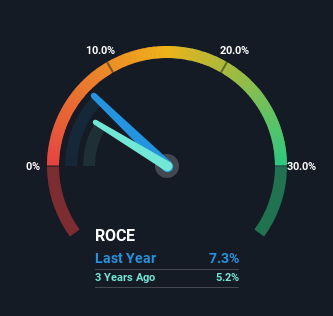TI Fluid Systems (LON:TIFS) Is Finding It Tricky To Allocate Its Capital
When researching a stock for investment, what can tell us that the company is in decline? A business that's potentially in decline often shows two trends, a return on capital employed (ROCE) that's declining, and a base of capital employed that's also declining. This reveals that the company isn't compounding shareholder wealth because returns are falling and its net asset base is shrinking. And from a first read, things don't look too good at TI Fluid Systems (LON:TIFS), so let's see why.
Return On Capital Employed (ROCE): What Is It?
Just to clarify if you're unsure, ROCE is a metric for evaluating how much pre-tax income (in percentage terms) a company earns on the capital invested in its business. To calculate this metric for TI Fluid Systems, this is the formula:
Return on Capital Employed = Earnings Before Interest and Tax (EBIT) ÷ (Total Assets - Current Liabilities)
0.073 = €151m ÷ (€2.8b - €709m) (Based on the trailing twelve months to June 2023).
Thus, TI Fluid Systems has an ROCE of 7.3%. In absolute terms, that's a low return and it also under-performs the Auto Components industry average of 9.8%.
View our latest analysis for TI Fluid Systems
Above you can see how the current ROCE for TI Fluid Systems compares to its prior returns on capital, but there's only so much you can tell from the past. If you'd like, you can check out the forecasts from the analysts covering TI Fluid Systems here for free.
The Trend Of ROCE
The trend of ROCE at TI Fluid Systems is showing some signs of weakness. The company used to generate 11% on its capital five years ago but it has since fallen noticeably. On top of that, the business is utilizing 21% less capital within its operations. When you see both ROCE and capital employed diminishing, it can often be a sign of a mature and shrinking business that might be in structural decline. If these underlying trends continue, we wouldn't be too optimistic going forward.
What We Can Learn From TI Fluid Systems' ROCE
In summary, it's unfortunate that TI Fluid Systems is shrinking its capital base and also generating lower returns. It should come as no surprise then that the stock has fallen 31% over the last five years, so it looks like investors are recognizing these changes. With underlying trends that aren't great in these areas, we'd consider looking elsewhere.
TI Fluid Systems does have some risks though, and we've spotted 1 warning sign for TI Fluid Systems that you might be interested in.
While TI Fluid Systems isn't earning the highest return, check out this free list of companies that are earning high returns on equity with solid balance sheets.
Have feedback on this article? Concerned about the content? Get in touch with us directly. Alternatively, email editorial-team (at) simplywallst.com.
This article by Simply Wall St is general in nature. We provide commentary based on historical data and analyst forecasts only using an unbiased methodology and our articles are not intended to be financial advice. It does not constitute a recommendation to buy or sell any stock, and does not take account of your objectives, or your financial situation. We aim to bring you long-term focused analysis driven by fundamental data. Note that our analysis may not factor in the latest price-sensitive company announcements or qualitative material. Simply Wall St has no position in any stocks mentioned.

